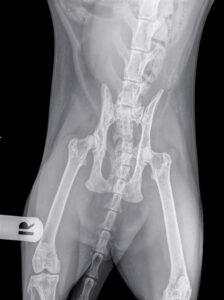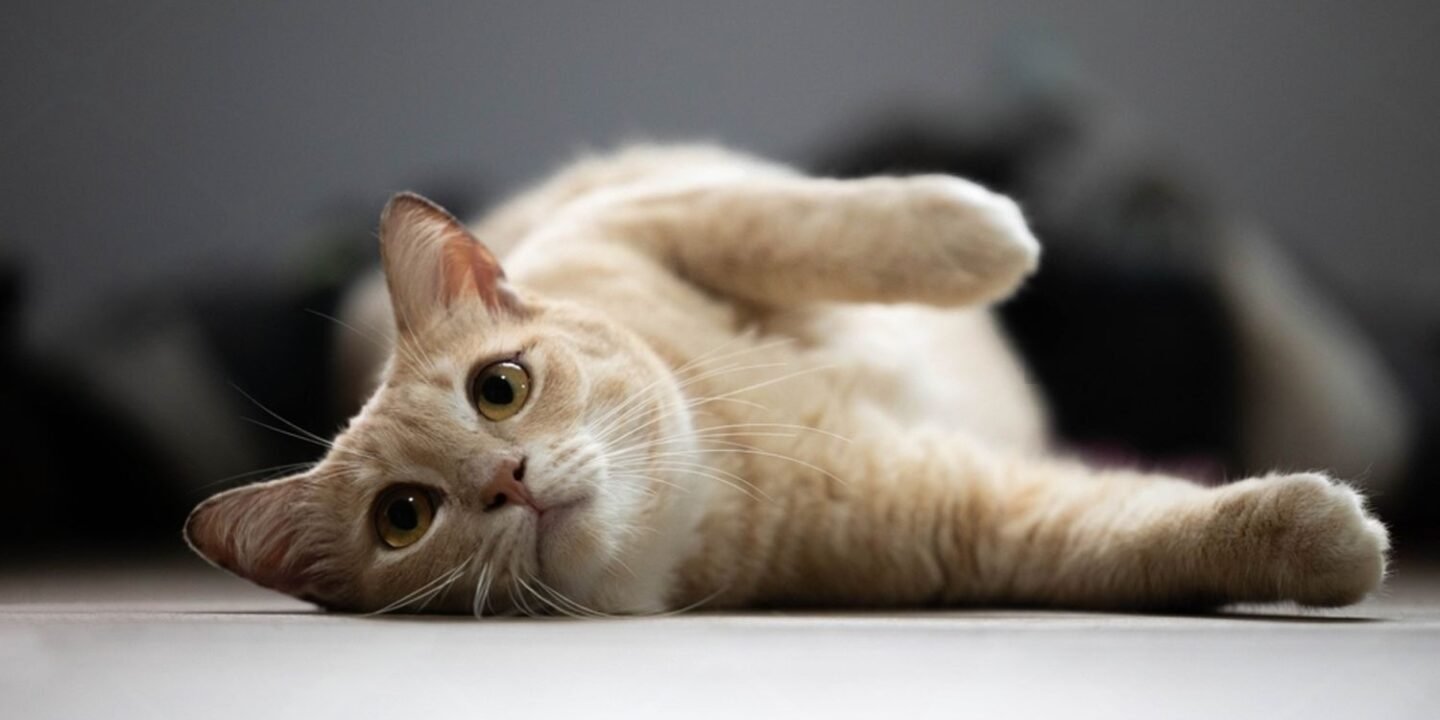Hip dysplasia in cats is a developmental condition where the hip joint does not form properly, leading to instability, pain, and eventually arthritis. While more commonly discussed in dogs, this disorder can affect cats too—especially certain breeds like Maine Coons and Persians. The challenge for pet owners is that cats are experts at hiding discomfort, so the condition often goes unnoticed until it becomes advanced.
Recognizing what hip dysplasia in cats is and spotting the early warning signs is critical. With timely diagnosis and proper management, many cats can continue to live comfortably and maintain a good quality of life. Early intervention not only helps control pain but also slows the progression of joint damage, giving your cat the best chance at staying active and healthy.
What Causes Hip Dysplasia in Cats?
The primary cause of hip dysplasia in cats is genetics. When kittens are born with loose or poorly developed hip joints, the ball and socket of the hip do not fit together correctly. This instability, known as genetic hip dysplasia in cats, is most often seen in large or purebred cats such as Maine Coons, Persians, and Himalayans.
While genetics set the stage, several environmental factors can make the condition worse. Rapid growth during kittenhood, excess body weight, or traumatic injuries to the hip can place additional strain on the joint. Over time, this abnormal movement wears down the cartilage and creates inflammation, leading to secondary arthritis and chronic pain.
In short, hip dysplasia doesn’t develop overnight—it is a gradual process that starts with poor joint structure and progresses into arthritis if not recognized and managed early.
Early Signs of Hip Dysplasia in Cats
Spotting the signs of hip dysplasia in cats can be tricky because felines instinctively mask pain. However, careful observation at home often reveals subtle changes in behavior and movement. Common symptoms of hip dysplasia in cats include:

- Reluctance to jump or climb: Cats may stop leaping onto furniture or hesitate before climbing stairs.
- Litter box challenges: High-sided boxes can become difficult to enter, leading to accidents or avoidance.
- Limping and stiffness: Many cats show a stiff gait after resting or develop a “bunny-hopping” motion when moving quickly.
- Grooming changes: Cats may over-groom sore hips or avoid being touched in that area altogether.
Stage-by-Stage Symptom Progression
- Mild: Subtle reluctance to jump, short bursts of activity followed by rest.
- Moderate: Noticeable limp, difficulty with stairs, decreased playfulness.
- Severe: Persistent stiffness, inability to jump, visible muscle loss in the hind legs, reduced mobility.
Recognizing these symptoms early is essential. What looks like “slowing down” with age could actually be the early stages of hip dysplasia, and timely veterinary care can make a significant difference in long-term comfort.
When to See a Veterinarian
Not every stiff step means a serious problem, but certain hip dysplasia in cats should never be ignored. You should schedule a veterinary appointment right away if you notice:
- Sudden limping or lameness that does not improve within 24–48 hours.
- Complete refusal to jump onto furniture or climb stairs.
- Aggression or sensitivity when the hips are touched—hissing, biting, or hiding.
- Loss of interest in play or movement, especially if your cat was previously active.
Early veterinary care is crucial. A veterinarian can confirm whether the problem is hip dysplasia or another condition, such as arthritis or injury. Prompt diagnosis allows for earlier treatment, which can slow the progression of arthritis, reduce pain, and preserve mobility.
If you’re unsure when to see a vet, the safest approach is to book an exam as soon as you notice consistent changes in mobility or behavior. Cats rarely show pain unless it is significant, so even subtle symptoms deserve attention.
How Vets Diagnose Hip Dysplasia in Cats
Accurate diagnosis is essential because the symptoms of hip dysplasia in cats often overlap with other joint and mobility issues. When you bring your cat to the clinic, the veterinarian will perform a step-by-step evaluation to confirm the problem.
- Physical Examination: The vet will gently manipulate the hips to check for looseness, grinding, or discomfort. One common technique is the Ortolani test, which helps detect instability in the hip joint.
- Imaging Tests: To confirm the condition, X-rays are usually taken under light sedation. Radiographs allow the vet to see how well the ball fits into the hip socket and assess the degree of arthritis present.
- Ruling Out Other Conditions: Because limping and stiffness can also be caused by patellar luxation, traumatic injury, or general arthritis, your vet will use imaging and examination findings to distinguish hip dysplasia from these conditions.
If you’re wondering how to diagnose hip dysplasia in cats at home, the truth is—it’s not possible without veterinary imaging. While you can recognize warning signs, only a vet can confirm the diagnosis and create a treatment plan tailored to your cat’s needs.
Treatment for Hip Dysplasia in Cats
A. Non-Surgical Options (First-Line Care)
Not every cat with hip dysplasia requires surgery. In fact, many cases can be managed successfully with conservative care. The main goal of hip dysplasia treatment in cats is to reduce pain, maintain mobility, and slow the progression of arthritis.
- Weight Management
Excess body weight is one of the biggest contributors to joint stress. Keeping your cat at a healthy weight—or helping an overweight cat slim down—can significantly reduce hip discomfort. Your veterinarian may recommend a calorie-controlled diet and regular weight checks.
- Prescription Diets & Joint Supplements
Some therapeutic diets are specially formulated with omega-3 fatty acids, antioxidants, and controlled calories to support joint health. Supplements containing glucosamine, chondroitin, or green-lipped mussel may also improve joint lubrication and comfort. Always use products approved by your veterinarian to ensure safety and effectiveness.
- Pain Relief Medications
Cats with moderate to severe symptoms may benefit from veterinary-prescribed pain control. Because many human pain medications are toxic to cats, only a veterinarian should prescribe safe options, such as feline-approved NSAIDs used under close monitoring.
- Environmental Adjustments
Simple changes at home can make a big difference. Provide ramps or pet steps to favorite perches, use low-sided litter boxes for easier access, and place soft, supportive beds in warm areas to reduce stiffness. Non-slip mats can also help prevent slipping on smooth floors.
With consistent management, many cats remain active and comfortable without surgery. Your veterinarian can help design a personalized plan that balances diet, pain control, and lifestyle adjustments for long-term joint health.
B. Surgical Treatment Options
When non-surgical treatment is not enough to control pain or mobility issues, your veterinarian may recommend surgery. Surgical procedures are typically reserved for severe cases where conservative management fails to provide relief.
- Femoral Head Ostectomy (FHO)
- This is the most common hip dysplasia surgery in cats, especially for those under 20 pounds.
- During the procedure, the femoral head (the “ball” of the hip joint) is removed, eliminating painful bone-on-bone contact.
- Over time, the surrounding muscles and scar tissue form a “false joint” that allows for pain-free movement.
- Cats generally recover well from FHO, often regaining good mobility within a few weeks to months.
- Total Hip Replacement (THR)
- While rare in felines, a total hip replacement may be considered in severe cases of hip dysplasia in cats, especially larger or overweight breeds.
- In this surgery, the damaged joint is replaced with an artificial implant, restoring more natural joint function.
- Recovery is longer and more intensive than FHO, but outcomes can be excellent with proper post-operative care.
- Recovery and Success Rates
- Most cats respond very well to surgical treatment, especially FHO. Success rates are high, with the majority experiencing significant pain relief and improved quality of life.
- Post-surgery rehabilitation—such as controlled exercise, weight management, and physiotherapy—plays a big role in long-term success.
👉 While surgery is not always necessary, knowing the available hip dysplasia in cats treatment options helps pet owners make informed decisions. Your veterinarian will guide you on whether non-surgical treatment for hip dysplasia in cats is enough or if surgery offers the best path forward.
At-Home Care and Lifestyle Adjustments
Managing hip dysplasia doesn’t stop at the veterinary clinic—consistent home care for hip dysplasia in cats is just as important for long-term comfort. Creating a supportive and accessible environment can significantly reduce strain on your cat’s joints. Soft bedding, non-slip rugs, and small step stools or ramps make it easier for your cat to reach favorite perches without painful jumps. Even switching to low-sided litter boxes can make daily routines less stressful.
Gentle play sessions and light physical therapy are also beneficial. Encouraging slow, controlled movements helps keep muscles strong without overloading the hips. Interactive toys that don’t require high jumps or sudden sprints are ideal. Your vet may also recommend specific stretching or range-of-motion exercises you can safely perform at home.
Monitoring is a key part of caring for a cat with hip dysplasia. Watch for subtle changes like increased stiffness, reluctance to move, or aggression when touched. These may indicate pain flare-ups that require veterinary attention or adjustments to their treatment plan. By combining an enriched, joint-friendly environment with ongoing observation, you can give your cat the best possible quality of life despite hip dysplasia.
Prognosis and Long-Term Outlook
The prognosis for hip dysplasia in cats is generally positive when the condition is recognized early and managed consistently. While hip dysplasia is not curable, most cats can still live long, fulfilling lives with the right combination of veterinary treatment, pain management, and at-home care. Many cats adapt well to their physical limitations and continue to enjoy daily activities, especially when their environment is adjusted to reduce stress on the hips.
It’s important for owners to understand that hip dysplasia is a chronic condition, not a temporary problem. This means flare-ups of pain or stiffness may occur throughout a cat’s life, but with proactive monitoring and intervention, these episodes can often be minimized. Life expectancy with hip dysplasia in cats is typically unaffected, as long as the condition is managed; most cats live out a normal lifespan.
Frequently Asked Questions
Can hip dysplasia in cats be cured?
No, hip dysplasia cannot be fully cured. However, treatments like weight control, supplements, pain relief, and in some cases surgery, can greatly improve comfort and mobility.
At what age do symptoms of hip dysplasia appear?
Symptoms of hip dysplasia in cats can appear as early as 6 months to 1 year, especially in genetically predisposed breeds such as Maine Coons. However, many cats don’t show signs until middle or senior age, when joint wear and tear worsens.
What’s the difference between hip dysplasia and arthritis in cats?
Hip dysplasia in cats is a developmental condition where the hip joint doesn’t form properly, leading to looseness and instability. Arthritis in cats, on the other hand, is a degenerative disease that causes joint inflammation and pain, often as a secondary effect of hip dysplasia. In short, hip dysplasia causes joint misalignment, while arthritis is the painful wear-and-tear outcome.
Is surgery worth it for cats with hip dysplasia?
Surgery is usually considered when non-surgical treatment no longer provides relief. For younger or smaller cats, an FHO often results in excellent mobility and comfort. While Total Hip Replacement is rare in cats, it can restore near-normal function in severe cases. Whether surgery is worth it depends on the cat’s age, weight, severity of pain, and overall health.
How do I make my home comfortable for a cat with hip dysplasia?
Home care for hip dysplasia in cats is essential for quality of life. Provide soft, supportive bedding, non-slip rugs, and ramps or step stools to help them access favorite spots without jumping. Heated beds and gentle play also help ease stiffness. Monitoring for pain flare-ups ensures early adjustments to care.






